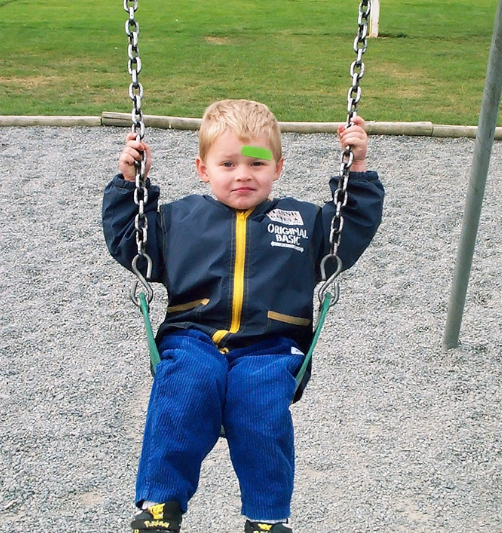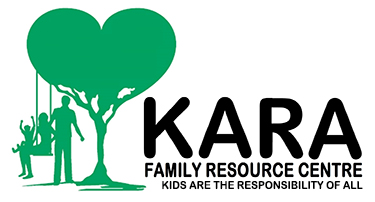
Last night, I was reading my children some goodnight stories when my older son, Grizzly Bear, decides it’s a good idea to start a game of tag. He was quite overtired and in that giddy mood he gets in when he needs some serious ZZZs. He booked it for the door as I called to him to lie down on his pillow. With a giant grin, he turned back to me but his legs kept going, misjudging the distance and causing his little body to hit and bounce off of the doorframe, landing two feet from where it was moments beforehand. He looked like a cartoon character. I tried desperately to stifle my laughter while picking his crumpled body off of the floor, cooing that he was going to be alright and just needed some Mommy magic kisses.
However, after taking a closer look, I noticed he had actually cut himself and sustained bruising on his forehead.
Bumps and Bruises
If your child sustains a bruise, it’s important to assess the situation to make a healthy decision for your child. Alberta Health Services suggests to call Health Link Alberta at 811 or make an appointment with your pediatrician. Bruises may not be serious but the action that caused the bruise could have caused something more worrisome, like a bone fracture or concussion. Always watch your child for clues, like pain, swelling, dizziness, tiredness, or slurred speech (not always that obvious with little ones but trust your instincts).
If caring for a bruise at home, follow the doctor’s orders, which could include pain medicine, ice packs, or keeping the body part elevated above the heart.
If the bruise is not serious, still watch your child for any indications that medical attention is needed. If the bruise starts off a blue-black colour but then starts to change colour, it is healing. If the bruise starts leaking or red streaks appear around it, it could be a sign of infection and you should seek immediate medical attention. To learn more on caring for bruises, follow this link.
Trips and Falls
My younger son, Polar Bear, recently caught his Mommy’s addiction to shoes. He loves to try them on and wear them around the house all day long. So when spring sprang into action and I pulled out some fancy new camouflage rain boots that lit up as he walked, his heart went all a twitter and he started to wear them everywhere, including down the stairs. His developmental skills had not caught up to his shoe fetish and I did not anticipate his tumble! To the hospital we went!
Children are naturally top-heavy. Their heads are disproportionately larger than their bodies, which makes them adorable but also prone to falls. Additionally, with larger, heavier heads, it also means their heads are likely to hit the ground first. Even more worryingly, falls account for the majority of childhood injuries in Alberta. This is largely due to the developmental stages of young children learning to walk and climb.
In the case of injuries from falls, the best action is prevention by managing risks. Caregivers need to assess their child’s developmental stage and adjust the activities accordingly. Young children need continual supervision and devices to keep them out of harm’s way, such as babyproofing stairs. As children age, the prevention methods should change to match their skills and development, such as teaching them the proper ways of doing activities, like holding the handrail on the stairs. Prevention should never reduce or take away from physical activities. Instead, prevention allows for activities to occur in a safer environment (click here).
If your child does sustain a fall, assess the situation. If your child is not old enough to tell you what happened, Alberta Health Services suggests to take them to their doctor or hospital, even if it was just a little fall. It’s just too difficult to determine internal bleeding or concussions in a young child and a medical professional can help. Other signs of medical emergencies include constant crying, complaining of pain, vomiting, lethargy (won’t wake), difficulty walking/talking, and losing consciousness even for the briefest of moments. Additionally, if a child lands directly on the top of their head, such as falling from a great height, like a trampoline, take them to the hospital as a spinal injury is possible. Falls can be very serious; therefore, prevention is key! To learn more, follow this link.
Cuts and Burns
Last weekend we had the whole family over for a little campfire outside. Being proactive, we used a walled and roofed fire pit so there were no open flames. The walls and roof of the fire pit still get quite hot though. Low and behold, someone touched it and the older and wiser women in my family sprang into action! They held my child’s hand in a cup of clean, cold water for fifteen minutes to transfer the heat from his hand to the water. Quick thinking which greatly reduced my son’s pain and Mommy’s heartache. Next, we applied polysporin. Burns and cuts are very similar in that they both cause open wounds. Burns have just as great of a potential for infection as a cut, so it’s important to add an age appropriate antibiotic after cleaning the area. Lastly, we let him choose his favourite coloured band-aid!
Alberta Health Services defines three different kinds of burns. First, second, and third degree burns are evaluated based on their size, area of the body, and age and health of the child. If you are unsure of the severity of the burn, go to the hospital.
First degree burns and sunburns are usually treated at home with cool cloths, cool water, and aloe vera gels. Be certain to always read the label and choose age appropriate applications. If your child is under two, always visit the doctor to determine what can and cannot be used. And always protect a wound that is in the process of healing. Keep it from getting dirty and keep it out of sunlight – use a colourful band-aid!
For any second or third degree burns to your child, go directly to the hospital. Cover the burn with a clean, dry cloth. Do not apply any medicines. Do not apply ice as it could greatly damage the skin (click here).
Treat cuts and scrapes in a similar fashion to burns. Assess the size, location, and child. Use clean water and age appropriate antibiotics for small, superficial wounds. My rule of thumb, if it’s too big to cover with a child-sized band-aid, of if blood is leaking out, indicating it’s deep, we go see our doctor!
Follow-up
The best defense is prevention! Try to make your child’s play spaces safe from bruises, falls, and burns. Summertime is usually jam-packed full with fun in the sun activities – let’s keep them safe! Use sunscreen, trampoline nets, and teachings to help your child develop in a safe environment. Pick up some age appropriate antibiotics and colourful band-aids too. You will never know when you’ll need them next – apparently not even Mommy’s bed-time stories are safe!
